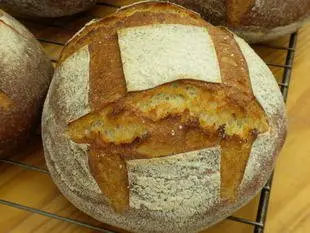New leavened bread
A recipe from cooking-ez.com December 30th 2019932 K 34.2
For 2 loaves, you will need:
- 1 1 kg plain white flour (French Type 65)
- 2 550 ml water
- 3 18 g fine (or table) salt
- 4 500 g leaven
- 5 2 g yeast
- Total weight: 2,070 grams
Times:
| Preparation | Resting | Cooking | Start to finish |
|---|---|---|---|
| 50 min. | 5 hours 30 min. | 40 min. | 7 hours |
Step by step recipe
- 1: In bread-making, the water temperature is always important. It's not a fixed value, but related to 3 other temperatures: 1) the temperature of your flour, 2) the room temperature in your kitchen, and 3) the basic temperature of this recipe, which is 56-60°C.
You can calculate the temperature of the water for this recipe in one click, using this small calculator. - 2: Put into the mixer bowl just 1 kg plain white flour (French Type 65) and 550 ml water at the right temperature.
Knead at minimum speed for 3 minutes. - 3: Leave the dough in the mixer, cover with a plastic sheet, and leave to rest for 1 hour.
- 4: At the end of this time, add 18 g fine (or table) salt, 500 g leaven and 2 g yeast.
- 5: Knead at minimum speed for 10 minutes.
Note: For the best way to knead, see: A few tips for effective kneading at home. - 6: After kneading, you can check the temperature of the dough, which should be 75°F (24°C), or better try the window-pane test.
- 7: Turn the ugh out onto the worktop and gather into a rough ball.
- 8: Put the dough into a large floured bowl.
Cover with a plastic sheet, and leave to rest in a warm place for 1.5 to 2 hours. - 9: After resting, tip the dough onto your worktop.
- 10: Divide into lumps of 500 grams (small loaves) or 1 kilo (large loaf).
- 11: Shape each lump of dough into a ball, cover with a plastic sheet and leave to rest for 30 minutes.
- 12: Press the dough flat again before shaping into round or long loaves.
- 13: Put into floured bannetons (rising baskets).
- 14: Cover with a plastic sheet and leave to rest for 2 hours.
- 15: As these actions are rather difficult to describe, you can watch this short demonstration video on the right.
- 16: Preheat the oven to 240°C or 464°F.
Dust each loaf with flour, then turn it over onto the peel (bread oven "shovel") and slash it across the top. - 17: Put in the for approximately 40 minutes (check near the end of cooking time).
Note: As when baking any bread, you should ensure that the oven is filled with steam for the first 15 minutes of baking. This page shows you how; it really is the secret of golden-brown, crusty loaves..
Remarks
If you can, try a slow rising by replacing the last 2 hours of resting (stage 8) by 10 hours at 50°F (10°C).If you'd like more information on making your own bread, you can consult this special page.
Yeast in leaven-raised bread?
Many of you are puzzled by the presence of yeast in a leaven-raised bread. Here is a little clarification of the matter:
The yeast is there to make things easier; for a beginner leaven-raised bread is not easy to get right, especially first time. This is why these few added grams of yeast help. The dough rises more easily, even if your leaven is not at its best, and it makes a lighter crust.
There's nothing shocking in this. You should be aware that even some commercially produced breads advertised as "leavened", also contain a little (more) yeast, for similar reasons, and it's perfectly legal.
In any case, there's no reason to be worried about yeast; it's not a chemical product. It too is a living organism, and it's not added to work against the leaven, rather something you can use alongside if you wish. Being able to proclaim proudly, "I don't use any yeast!" is, in my humble opinion, rather overrated.
That said, adding a little yeast does have one slight drawback, in that it dulls the flavour of the bread somewhat. If you want to make leavened bread for its characteristic flavour, you'll lose a little, even with a small quantity of yeast.
In conclusion, I advise the following approach: if you are just starting out, add a little yeast. Then, once you have mastered the basics and can produce good bread, leave it out. You can then compare both methods and choose.
View this recipe : https://cooking-ez.com/four/recipe-new-leavened-bread.php
December 28th 2025.

